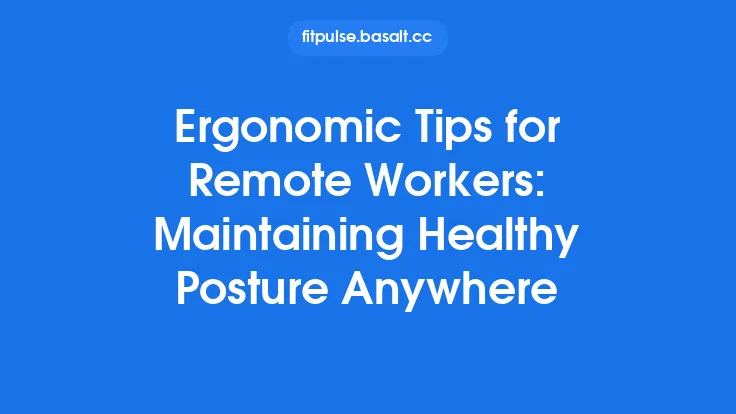Spending hours hunched over a computer can silently erode the very mobility that calisthenics relies on. Even the most disciplined bodyweight athlete will notice a decline in range of motion, joint health, and movement quality if the daily desk routine is not counterbalanced with ergonomic awareness. Below is a comprehensive guide that blends workplace ergonomics with calisthenics‑focused mobility, giving desk workers the tools they need to preserve—and even enhance—their functional movement patterns.
Understanding the Desk‑Work Body Mechanics
1. The “Closed‑Chain” vs. “Open‑Chain” Dilemma
When you sit, your lower limbs become part of a closed kinetic chain: the feet are fixed to the floor, the hips are flexed, and the lumbar spine is often rounded. In contrast, calisthenics movements such as push‑ups, pull‑ups, and pistol squats demand open‑chain dynamics where joints move through full, unrestricted arcs. The transition between these two states creates a mechanical mismatch that can lead to stiffness, especially in the hip flexors, thoracic spine, and posterior chain.
2. Common Postural Deviations in Desk Workers
| Deviation | Primary Muscles Affected | Calisthenics Impact |
|---|---|---|
| Forward head posture | Upper trapezius, levator scapulae, suboccipitals | Reduces scapular stability, hampers overhead presses |
| Rounded shoulders | Pectoralis major/minor, anterior deltoids | Limits shoulder external rotation, affecting handstand alignment |
| Anterior pelvic tilt | Hip flexors (iliopsoas, rectus femoris), lumbar extensors | Decreases hip extension power, compromises deep squats |
| Lumbar flexion (slouch) | Erector spinae, multifidus | Weakens core bracing, increasing injury risk during L‑sits or front levers |
Understanding these patterns is the first step toward targeted ergonomic interventions that protect and improve mobility.
Optimizing Your Workstation for Mobility
1. Chair Selection and Adjustment
- Seat Height: Aim for a 90‑degree knee angle with feet flat on the floor. This aligns the femur with the tibia, reducing stress on the hip flexors.
- Seat Depth: The back of the knee should have a 2‑3 cm clearance to avoid compressing the popliteal fossa, which can impede circulation.
- Lumbar Support: Use a contoured lumbar pillow or an adjustable lumbar roll positioned at the natural lordotic curve (approximately the L3–L5 vertebrae). This encourages a neutral spine, essential for maintaining core tension during calisthenics.
2. Monitor Placement
- Eye Level: The top third of the screen should be at eye level, roughly 50–70 cm away. This prevents forward head posture and encourages a neutral cervical spine.
- Screen Tilt: A slight backward tilt (10–15°) reduces glare and encourages a relaxed neck position.
3. Keyboard and Mouse Ergonomics
- Keyboard Height: Keep the keyboard at elbow height when the forearms are parallel to the floor. This maintains a neutral wrist extension (0–15°) and reduces forearm pronation, preserving wrist mobility for planche and handstand work.
- Mouse Position: Place the mouse close to the keyboard, within easy reach, to avoid excessive shoulder abduction. Consider a vertical mouse to keep the forearm in a neutral pronation/supination position.
4. Desk Height and Surface
- Standing Desk Integration: If possible, alternate between sitting and standing. A desk height that allows elbows to stay at a 90‑degree angle when typing while standing (roughly 100–110 cm for most adults) promotes active posture.
- Anti‑Fatigue Mat: When standing, a cushioned mat encourages subtle micro‑shifts in weight distribution, preventing static loading of the lower back and calves.
Micro‑Movement Strategies for the Desk
Even with an optimal setup, prolonged static postures are inevitable. Incorporating micro‑movements—tiny, frequent adjustments—keeps joints lubricated and muscles engaged.
1. The “Desk‑Based Cat‑Cow”
- How: While seated, place hands on knees. Inhale, arch the back (cow) and lift the chest; exhale, round the spine (cat) and tuck the chin.
- Reps: 8–10 cycles every hour.
- Benefit: Mobilizes the thoracic spine and re‑educates the lumbar curve, directly supporting the scapular retraction needed for pull‑ups.
2. Hip Flexor “Desk‑Dip”
- How: Sit near the edge, place one foot flat, the other on a low stool or box. Gently shift weight forward, feeling a stretch in the back leg’s hip flexor. Hold 15 seconds, switch sides.
- Frequency: 3 sets per side, twice daily.
- Benefit: Counteracts anterior pelvic tilt, improving hip extension for pistol squats and jumping variations.
3. Shoulder Blade Squeezes
- How: Sit upright, pull shoulder blades together and down (as if trying to hold a pencil between them). Hold 5 seconds, release.
- Reps: 12–15, every 30 minutes.
- Benefit: Activates the middle trapezius and rhomboids, balancing the overactive chest muscles that limit overhead mobility.
4. Ankle Rockers
- How: While seated, lift the toes, then rock the heels down, creating a gentle dorsiflexion‑plantarflexion wave.
- Reps: 20–30 per foot, every hour.
- Benefit: Maintains ankle dorsiflexion range, crucial for deep squat depth and stability in handstand entries.
Structured Mobility Breaks Aligned with Calisthenics Principles
Micro‑movements keep the body from “locking up,” but dedicated mobility sessions reinforce the movement patterns used in calisthenics.
| Break Length | Focus Area | Sample Routine (5‑10 min) |
|---|---|---|
| 5 min (mid‑morning) | Thoracic Extension & Shoulder Mobility | 1. Wall Angels (2 × 10) 2. Band Pull‑Apart (3 × 15) 3. Thread‑the‑Needle Stretch (30 s/side) |
| 5 min (post‑lunch) | Hip Flexor & Hamstring Flexibility | 1. Kneeling Hip Flexor Stretch with Reach (2 × 30 s/side) 2. Standing Hamstring Sweep (2 × 30 s/side) 3. Deep Squat Hold (1 × 1 min) |
| 5 min (late afternoon) | Wrist & Forearm Conditioning | 1. Wrist Flexor/Extensor Stretch (30 s/side) 2. Finger‑to‑Thumb “C” Grip Holds (3 × 20 s) 3. Reverse Wrist Push‑Ups (2 × 8) |
| 10 min (end of day) | Full‑Body Integration | 1. Cat‑Cow (10 reps) 2. Scapular Push‑Ups (10 reps) 3. Hip CARs (Controlled Articular Rotations, 5 each direction per side) 4. Standing Calf Stretch (30 s/side) |
These breaks are deliberately short to fit into a typical office schedule while still delivering the joint‑specific stimulus needed for calisthenics performance.
Equipment Recommendations for Desk‑Based Mobility
While many adjustments rely on body awareness, a few low‑cost tools can amplify results:
| Tool | Primary Use | Why It Helps Calisthenics |
|---|---|---|
| Foam Roller (medium density) | Myofascial release for thoracic spine, glutes, and calves | Improves tissue pliability, allowing deeper squat and handstand positions |
| Resistance Band (light‑to‑medium, 15–30 lb) | Band pull‑apart, shoulder dislocates, hip abduction | Enhances scapular stability and hip external rotation, both essential for pull‑ups and pistol squats |
| Portable Lumbar Pillow | Dynamic lumbar support during seated work | Encourages neutral spine, reducing compensatory lumbar flexion that limits core bracing |
| Desk‑Mounted Under‑Desk Elliptical | Low‑impact leg movement while seated | Maintains ankle range and promotes circulation without breaking workflow |
| Wrist Roller | Wrist flexor/extensor strengthening | Directly supports grip endurance for hanging exercises and planche progressions |
Investing in one or two of these items can transform a static workstation into a mobility‑friendly environment.
Integrating Ergonomic Awareness into Calisthenics Skill Development
1. Transfer of Learning
When you practice a skill like a handstand, the body seeks the most efficient alignment. If your daily posture has ingrained a forward‑leaning ribcage, the handstand will feel “off‑balance.” By consistently correcting posture at the desk, you reinforce the proprioceptive cues needed for skill acquisition.
2. Progressive Overload of Mobility
Just as you add reps or difficulty to a push‑up, you can progressively increase the intensity of mobility work:
- Stage 1: Static stretches (e.g., hip flexor hold).
- Stage 2: Dynamic movements (e.g., hip CARs).
- Stage 3: Load‑bearing positions (e.g., deep squat with a light kettlebell).
Apply the same principle to desk ergonomics: start with basic adjustments, then introduce active elements like a standing desk or a balance board.
3. Monitoring Progress
Use simple metrics to gauge improvement:
- Sit‑to‑Stand Test: Time how long it takes to perform 10 full squats from a seated position. Faster times indicate better hip and ankle mobility.
- Wall‑Slide Test: Slide your forearms up a wall while keeping elbows at 90°. If you can reach full extension without arching the lower back, thoracic mobility has improved.
Reassess every 4–6 weeks to ensure ergonomic changes are translating into functional gains.
Common Pitfalls and How to Avoid Them
| Pitfall | Why It Happens | Corrective Action |
|---|---|---|
| “Ergonomic set‑and‑forget” | Belief that a single adjustment solves the problem. | Conduct a weekly micro‑audit: check chair height, monitor angle, and posture cues. |
| Over‑stretching static muscles | Attempting long‑duration holds while the body is still. | Pair static stretches with dynamic warm‑ups; keep holds under 60 seconds for hip flexors. |
| Neglecting the lower back | Focus on shoulders and wrists only. | Incorporate lumbar extensions (e.g., prone “Superman” holds) during breaks. |
| Relying solely on equipment | Assuming a foam roller replaces movement. | Use equipment as a supplement, not a substitute for active mobility drills. |
| Skipping the warm‑up before intense desk work | Jumping straight into typing after a workout. | Perform a brief 2‑minute “desk warm‑up” (shoulder rolls, neck circles) to transition the nervous system. |
A Sample Day‑In‑The‑Life Workflow
| Time | Activity | Ergonomic/ Mobility Focus |
|---|---|---|
| 08:00 – 08:30 | Arrival, workstation setup | Adjust chair, monitor, keyboard; perform 2‑minute neck/shoulder warm‑up |
| 09:30 – 09:35 | First micro‑break | Desk‑based cat‑cow + shoulder blade squeezes |
| 11:00 – 11:05 | Mid‑morning mobility break | Wall angels + band pull‑apart |
| 12:30 – 13:00 | Lunch (stand‑up option) | Use standing desk, perform hip flexor dips and ankle rockers |
| 15:00 – 15:05 | Afternoon micro‑break | Wrist stretches + finger‑to‑thumb “C” holds |
| 16:30 – 16:40 | End‑of‑day mobility session | 10‑minute full‑body routine (cat‑cow, scapular push‑ups, hip CARs) |
| 17:00 | Wrap‑up | Quick workstation check, note any discomfort for next day’s adjustments |
By weaving these short, purposeful actions into the workday, you protect joint health, reinforce movement patterns, and set the stage for continued progress in calisthenics.
Final Thoughts
Ergonomics is often viewed as a passive, “set‑it‑and‑forget‑it” discipline, but for the dedicated calisthenics practitioner it becomes an active partner in performance. The desk is not an enemy; it is a daily platform where you can practice the very principles—neutral alignment, joint mobility, and muscular balance—that underpin bodyweight mastery. By implementing the ergonomic adjustments, micro‑movements, and structured mobility breaks outlined above, desk workers can not only prevent the typical stiffness and postural drift that sabotage training, but also actively enhance the range of motion, stability, and control required for advanced calisthenics skills. Consistency is the bridge between a sedentary office environment and a fluid, mobile body capable of executing pull‑ups, handstands, and pistols with confidence and longevity.





